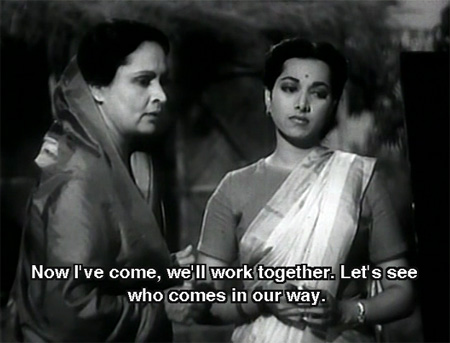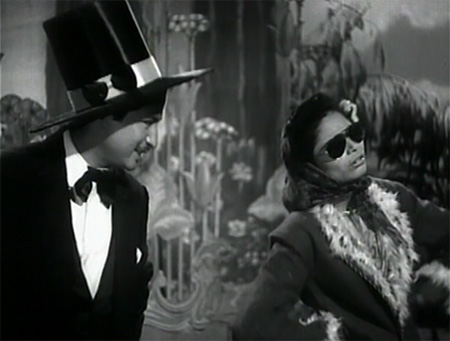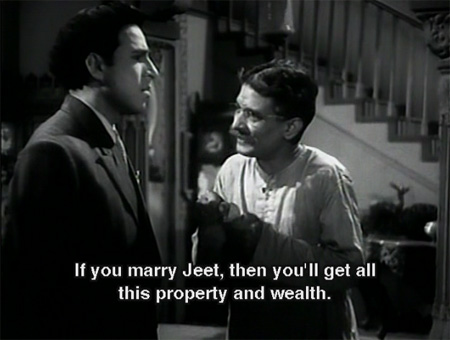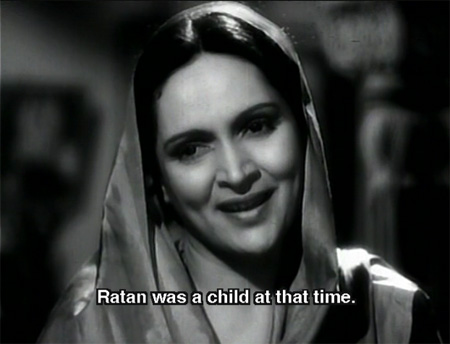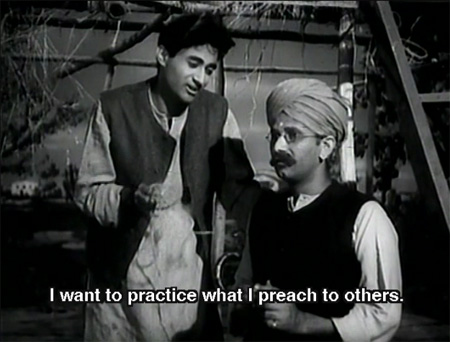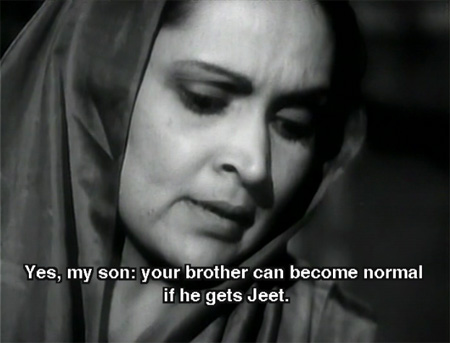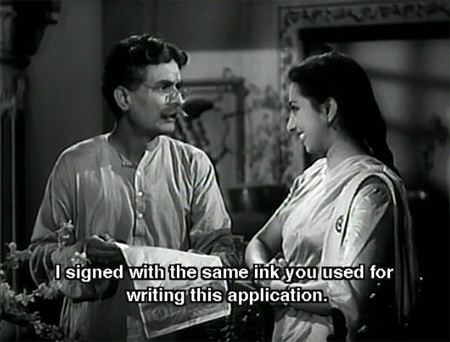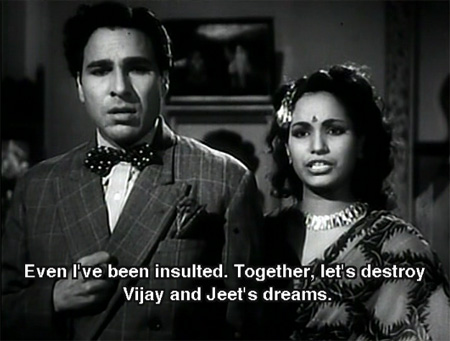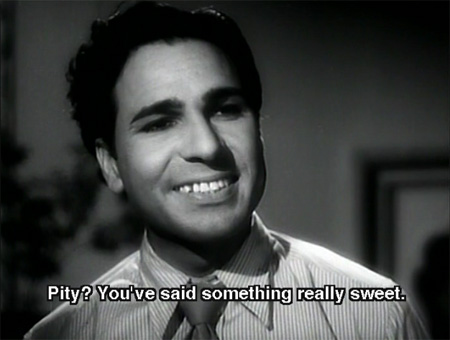One of the best things about Hindi movies for me is that they are a window into the growing pains—and hopes and joys—of a brand new nation. (I’m talking mostly about north India only since I don’t watch south Indian movies yet, but still. It’s there, in front of you.) Most cinema is reflective of its origins and time to some extent of course; but the timing of India’s independence, and the fledgling country’s tenacious adherence to specifically Indian traditions and issues, makes Hindi cinema particularly so (this is also true of the pre-independence period, although in a more veiled way). For this reason, I try to slog my way through the 1940s, although I find films from the era sometimes a little too melodramatic and preachy, and a little too song-saturated, to make it easy.
But I really enjoyed this one! It’s feminist! Chock-full of woman power, seriously! Sure, it’s heavy-handed (and laughably idealistic if one is a wee bit cynical), but it has such charm and youthful optimism (that same unknown cynic might call it naivete) that I got sucked right in. Plus, the incredibly young Dev Anand and Madan Puri are so…incredibly young!
Suraiya plays Jeet, an intelligent and fierce woman of means with very definite ideas about what is important to her. She has inherited a small fortune from her deceased father, and lives with her uncle Kalyan Singh (Kanhaiyalal) next door to Maa (a barely middle-aged Durga Khote—only six years post-Prithvi Vallabh). Jeet is in love with one of Durga’s sons, idealistic Vijay (Dev Anand), whose brother Ratan (Madan Puri) has just returned from living abroad in America.
It starts out a little unpromisingly with fervent speeches on behalf of a socialist and rooted-in-traditions India. Throughout the film Jeet is the main voice for the film’s message, with Vijay offering support rather than the other way around. I don’t know if this is because Suraiya was a bigger star than Dev Anand at this point in time, but it’s a refreshing change!
Then there’s a little bit of America-bashing (although Ratan springs to the defense of capitalism) and more idealism:
I sigh and wonder how soon it will be before I want to blow my head off (all this and more in only 8 minutes or so!). But gears shift pretty quickly into an actual—and entertaining—storyline. There are deep divisions in the village between the poor majority and the few wealthy zamindars and moneylenders who inhabit it. Despite her own wealth, Jeet is dedicated to helping the farmers and workers who live around her; Vijay is equally dedicated to helping her.
I have to say here that Suraiya and Dev Anand are very sweet in this. I think their real-life romance must have been going strong here; their comfort level and happiness together shines from the screen. I especially love their duet “Chahe Kitni Kathin Dagar Ho,” sung by Suraiya and Shankar Dasgupta—Shankar Dasgupta was heretofore unknown to me, but his voice blends beautifully with hers and I think it suits Dev very nicely as well. And the song is picturized simply on the two (Dev and Suraiya) walking along hand in hand—so cute. I’m putting it here as it’s not easy to find.
Anyway, on the evening of Ratan’s arrival the entire village attends a play performance, and Jeet sings a song whose lyrics aren’t subtitled but whose meaning is clear. This “modern” pair are clearly meant as figures of fun!
Infuriated at what he perceives as an insult from Jeet, Ratan storms out. The next day Jeet’s cousin Kiran arrives from the city, where she has been studying surgery at a Medical College. I think Kiran is played by Suraiya Chowdhury—at least she’s the actress in the highest credit order who I’m not already familiary with. She seems very uncomfortable onscreen, swaying back and forth and swinging her purse as she delivers her lines. She does get a bit better by the end. Still, it’s distracting.
Ratan is clearly pleased to see her, and she is clearly a woman who could be his type, so I am confused when minutes later he confides in Kalyan Singh that he wants to marry—Jeet! The same Jeet who keeps insulting him in public!
Ahh. DUH. Jeet’s uncle is a greedy, greedy man too; he strikes a deal with Ratan that if Ratan can convince Maa, Vijay and Jeet that he should marry Jeet, he won’t stand in the way—as long as Ratan gives him half of Jeet’s inheritance. This seems a tall order, and indeed Maa’s first reaction is an emphatic “Never!” when her Munimji brings Kalyan’s proposal.
She isn’t talking about Jeet, either—it turns out that Vijay is not actually her son, but she adopted him when his parents died. And may I point out how very gorgeous Durga Khote was. What bone structure—what a face!
Ratan overhears her conversation with Munimji, and so does Vijay. Ratan orders him out of the house and Vijay leaves willingly, although Maa is greatly saddened by these events. He’s happy enough though, and begins building his own hut (oh! such a simple life!):
Ratan begins to pursue Jeet, who shows him nothing but scorn. She doesn’t care at all that Vijay is now living in a hut, and their love is as strong as ever. Ratan’s case still seems hopeless; but if there’s one thing I’ve learned, it’s to never ever underestimate the power of a favorite older son over an indulgent and wishful Maa!
The support he needs? Jeet, of course! Reluctantly, Maa goes to see Vijay and asks him to sacrifice his love for her sake.
How I love Hindi movie psychology! To his credit, a heartbroken Vijay says it will have to be up to Jeet. And Jeet’s uncle has not stopped his assault on her fortune either. He asks her to put her signature on a blank piece of paper, assuring her that he won’t cheat her. She pretends to sign—but you can’t pull the wool over this girl’s eyes so easily.
Vijay tells Jeet in the meantime what his Maa has asked of him. Fed up, she goes to the village elders, who her uncle is now trying to manipulate, and accuses him in front of them of trying to cheat her. Kiran appears in the middle of this speech (I’ve now started swaying and rocking when I see her) in time for Jeet’s dramatic announcement.
She signs over all her wealth and property to Kiran! I love this more than I can say: in one bold movie she’s completely thwarted her uncle and gotten rid of Ratan as well. Kiran goes to see Ratan, and he immediately switches his affections to her when she shows him the papers signed by Jeet.
Jeet meets Vijay and tells him what she’s done; they go and get Maa, and the three of them go to meet Ratan, only to find him romancing Kiran. Maa is furious—and disappointed—at his duplicity and leaves with Vijay and Jeet. Ratan is insulted (apparently by Jeet’s keen insight into his psyche) and vows to avenge himself; Kiran chimes in too.
Can Jeet’s intelligence and moxie keep Maa, Vijay and herself safe? Her uncle is mad too, and the wealthy men of the village are not happy with Vijay and Jeet’s social work. Will the power of wealth defeat the hard work and idealism of the poor? Watch Jeet to find out, and for lots of angry villagers with sticks and paranoid landowners! Oh, newly independent India—how did you survive?
Seriously though, I enjoyed this film despite being bashed over the head with idealistic sermons—and to be fair, there are some interesting arguments introduced too. The Dev-Suraiya romance is sweet, and it’s more fun than I can describe to see Jeet exercising her considerable powers. She is smart, loving, and willing to stand up for her beliefs; when her Maa-in-law finally joins in, can anything stop them? There are too many songs for my tastes, but most of them are really lovely and all of them are relatively short, as is the film itself (just over two hours). Lata sings a couple of songs, one of her early films, and so does Geeta Dutt, in addition to Suraiya singing for herself.
Plus, it’s just a whole lot of fun to see such a young Madan Puri as well.
If you want to stick your toe in early Hindi movie waters, this isn’t a bad place to start.
